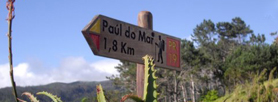PR 19 Paul do Mar Footpath
 Start: Prazeres
Finish: Paul do Mar
Time: 1h20m
Distance: 1.8 km
This walk is located in the western area of Madeira Island. It links the parish of Prazeres with Paúl do Mar and drops from an altitude of 550 metres to sea level.
In the parish of Prazeres, take advantage of the opportunity to visit the Learning Farm with its various animals, as well as the Casa de Chá (Tea House), where you can savour infusions of aromatic and medicinal herbs and purchase traditional sweets made with organically-grown fruit.
The descent is made along the face of the cliff between Assomadouro at Prazeres and the dock at Paúl, winding between terraced farm plots, held in place by stone walls, formerly used for growing grain crops, but with the subsequent decline of agriculture, today they are largely abandoned.
Assomadouro is the name given to the place from whence something interesting can be seen, being a synonym for miradouro (belvedere). In fact, the view from here is superb, with beautiful panoramic views to the left (the tiny parish of Jardim do Mar) and to the right (Paúl do Mar) that are truly dazzling.
Designated as a “municipal path”, it is an example of the difficult access routes that were traversed many times with heavily laden backs, and which were the only viable alternative, the other being access by sea, which was too expensive for many and impossible when the sea was raging.
This trail is a genuine historical heritage, winding along the steep slope in a zigzag pattern, its stone footpath comprising small stair steps bearing witness to the isolation of past generations and testament to the ingenious and difficult trails built by the people in attempting to overcome this isolation.
Waterfalls and endemic flora exclusive to these altitudes, such as pride of Madeira (Echium nervosum) and Madeira mountain stock (Euphorbia piscatoria), help to ensure that this trail is truly one of discovery When you reach Paúl do Mar, be sure to explore this small parish on the seashore and wonder at the high cliffs that surround it. At one time, it was an important fishing village, and due to the great abundance of fish, a canning factory was set up here to export tuna in 1912.
Today, you can still see remnants of the chimney of that factory, as well as the salt pools, the sugar cane mill and the small fishing port together with its typical fishing boats that still keep the maritime traditions alive.
Start: Prazeres
Finish: Paul do Mar
Time: 1h20m
Distance: 1.8 km
This walk is located in the western area of Madeira Island. It links the parish of Prazeres with Paúl do Mar and drops from an altitude of 550 metres to sea level.
In the parish of Prazeres, take advantage of the opportunity to visit the Learning Farm with its various animals, as well as the Casa de Chá (Tea House), where you can savour infusions of aromatic and medicinal herbs and purchase traditional sweets made with organically-grown fruit.
The descent is made along the face of the cliff between Assomadouro at Prazeres and the dock at Paúl, winding between terraced farm plots, held in place by stone walls, formerly used for growing grain crops, but with the subsequent decline of agriculture, today they are largely abandoned.
Assomadouro is the name given to the place from whence something interesting can be seen, being a synonym for miradouro (belvedere). In fact, the view from here is superb, with beautiful panoramic views to the left (the tiny parish of Jardim do Mar) and to the right (Paúl do Mar) that are truly dazzling.
Designated as a “municipal path”, it is an example of the difficult access routes that were traversed many times with heavily laden backs, and which were the only viable alternative, the other being access by sea, which was too expensive for many and impossible when the sea was raging.
This trail is a genuine historical heritage, winding along the steep slope in a zigzag pattern, its stone footpath comprising small stair steps bearing witness to the isolation of past generations and testament to the ingenious and difficult trails built by the people in attempting to overcome this isolation.
Waterfalls and endemic flora exclusive to these altitudes, such as pride of Madeira (Echium nervosum) and Madeira mountain stock (Euphorbia piscatoria), help to ensure that this trail is truly one of discovery When you reach Paúl do Mar, be sure to explore this small parish on the seashore and wonder at the high cliffs that surround it. At one time, it was an important fishing village, and due to the great abundance of fish, a canning factory was set up here to export tuna in 1912.
Today, you can still see remnants of the chimney of that factory, as well as the salt pools, the sugar cane mill and the small fishing port together with its typical fishing boats that still keep the maritime traditions alive.



